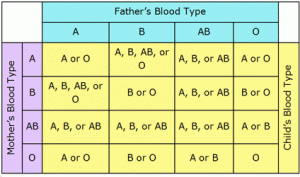Using Blood Types as a cheap way to perform paternity testing
The very first paternity tests were performed by comparing blood types. However, this method cannot provide a reliable evidence of paternity. However, sometimes it can eliminate a possibility to be a potential father.
Furthermore, you may already know each testing party’s blood type from medical records. In that case your expenses will equal zero.
ADVICE: If a man has ever worked for a military service, his blood type will be seen on his dog tags.
Even if you do not have this information on your hands for every single person, this method may be cheaper than performing a DNA paternity test.
Therefore it is necessary to identify the missing blood types before you cover the expenses for completing a DNA paternity test.
ABO Blood Groups
 Here you can find a short description on how the blood typing works.
Here you can find a short description on how the blood typing works.
There are four common types: A, B, AB, and O.
If you are already aware of the mother’s and child’s blood type, you can use the following chart to narrow the list of possible types for the alleged father.
Find the child’s value in yellow and the mother’s value in blue. Read down the child’s column and across the mother’s row to find the green cell where they cross one another.
The letters listed in that cell are the possible ABO groups of the alleged father.
For example, if the child is A and the mother is O, the father WILL be A or AB. Biologically, it is not possible for a man with B or O blood type to be the father of the child.
ATTENTION: The two blank cells mark impossible combinations between the mother and the child, disregarding the father.
Crucial limitations
According to the chart, there are some combinations of mother and child that show all four possibilities and, therefore, cannot eliminate any alleged father.
The most crucial limitation is that knowing this information can, at best, only eliminate the alleged father. All alone it cannot prove that any given man is the child’s real father.
Nonetheless, if the mother knows there are only two possible fathers, eliminating one of them will tell her that the other one is the biological father of her child.
If this does not provide an accurate result, or if you need a positive paternity test to fulfil legal requirements, you must still order a DNA paternity test.